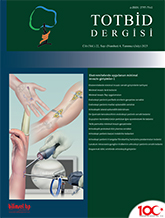
Throughout history, there has been a continuous development and innovation in orthopedic surgical interventions. These developments gain momentum as surgical experience increases and knowledge accumulates. This dynamic process has always been interesting and has guided the treatments. As the detailed anatomy of the extremities has been understood, the number of surgical treatments applied to the extremities has increased in the historical process. As the experience in surgical treatments increased and complications were better evaluated, some technical changes were made in surgical treatment methods and even the search for new methods began. A good understanding of the biological mechanisms of the healing processes of diseases also plays a major role in this development. Complications caused by large incisions and extensive soft tissue damage and the long healing times they cause revealed that other surgical techniques that can cause less damage to soft tissues should be defined. Based on the philosophy of approaching the most optimal result with less surgical trauma without sacrificing surgical goals, minimally invasive procedures were defined and started to be applied in increasing numbers by surgeons. Minimally invasive interventions in the extremities are used in the diagnosis and treatment of many diseases, especially fractures, sports traumas, neuropathies, arthroses and tendinopathies.